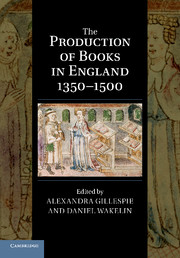Book contents
- Frontmatter
- Contents
- List of illustrations
- List of contributors
- Foreword
- Acknowledgements
- List of abbreviations
- Introduction
- 1 Materials
- 2 Writing the words
- 3 Mapping the words
- 4 Designing the page
- 5 Decorating and illustrating the page
- 6 Compiling the book
- 7 Bookbinding
- 8 Commercial organization and economic innovation
- 9 Vernacular literary manuscripts and their scribes
- 10 Book production outside commercial contexts
- 11 Censorship
- 12 Books beyond England
- 13 English books and the continent
- Afterword: the book in culture
- Bibliography
- Index of manuscripts
- General index
3 - Mapping the words
Published online by Cambridge University Press: 05 May 2014
- Frontmatter
- Contents
- List of illustrations
- List of contributors
- Foreword
- Acknowledgements
- List of abbreviations
- Introduction
- 1 Materials
- 2 Writing the words
- 3 Mapping the words
- 4 Designing the page
- 5 Decorating and illustrating the page
- 6 Compiling the book
- 7 Bookbinding
- 8 Commercial organization and economic innovation
- 9 Vernacular literary manuscripts and their scribes
- 10 Book production outside commercial contexts
- 11 Censorship
- 12 Books beyond England
- 13 English books and the continent
- Afterword: the book in culture
- Bibliography
- Index of manuscripts
- General index
Summary
During the period covered by this book, the English language witnessed some of the farthest-reaching changes in its entire history, including the loss of grammatical gender, the shift from a synthetic to an analytical structure and the introduction of huge numbers of loanwords into its lexicon. Perhaps the most significant change to the language during this period was the emergence of a standard variety of English, a variety which has since become so enshrined in our society that we tend to think of it as the English language. By contrast, during the Middle English period there was no single standard variety of English, and all regional dialects were considered to have equal status. A writer of Middle English simply employed the dialect native to the area in which he was trained to write, so that a Londoner such as Chaucer used the London dialect, while the Gawain-poet used his own North-West Midlands variety. This lack of a standard variety applied to writing as well as to speech, so that not only did a dialect speaker have a different accent from users of other dialects, he also had a different spelling system.
The reason for this lack of a standard spelling system is bound up with the status of the vernacular during the Middle English period and the dominance of Latin and French.
- Type
- Chapter
- Information
- The Production of Books in England 1350–1500 , pp. 59 - 78Publisher: Cambridge University PressPrint publication year: 2011
- 15
- Cited by



